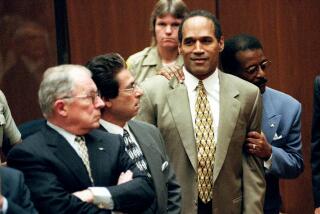How Can He Defend John Famalaro? With Human Touch
- Share via
The end of Leonard Gumlia’s anonymity draws ever nearer.
Although well-known in legal circles, Gumlia labors like all lawyers in the Orange County public defender’s office--largely unknown.
That will change, however, as Gumlia steps forward to defend John J. Famalaro, the man accused of kidnaping and killing Denise Huber and then storing her body in a freezer for three years. Because of the ubiquitous flyers that kept attention on Huber after her disappearance and, then, the bizarre discovery of her body last July in Arizona, Famalaro became one of the county’s most infamous criminal defendants.
Even Gumlia has told friends in shorthand language that everyone understands that the Famalaro trial will be “the O.J. of Orange County.”
We met Thursday morning, with Gumlia fresh from interviewing the night before a woman who had known Famalaro since the early ‘80s. She’s one of at least 200 people who knew him “reasonably well” and whom the defense may use to flesh out the details of Famalaro’s life, Gumlia says.
Those details are not incidental, because if a jury finds Famalaro guilty, the district attorney is asking for the death penalty. Gumlia and co-counsel Denise Gragg know that putting a human face on Famalaro may be the difference between life and death for him.
Part of the intrigue of this case, Gumlia says, is that Famalaro kept voluminous records of his activities and thoughts--through letters, journals and other documents and pieces of paper. The district attorney eventually collected about 150 boxes of materials, of which it has given about 30 to the defense, Gumlia says. The defense wants more and estimates that there may be as many as 100,000 separate pieces of paper that were in Famalaro’s possession when he was arrested.
Mindful of various high-profile cases recently, Gumlia is concerned about the public’s perception of defense attorneys. He concedes he’s thought “a lot about it” as this case approaches.
“The most disturbing part of the O.J. Simpson trial, at least to me, is that the reputation of defense lawyers is being adversely affected, badly, by the performance of the defense lawyers there. It plays into the stereotype of sleaze, and at times, underhandedness, things like that. To the extent that is transferred at all, yeah, there’s real concern, not about my reputation generally, but how we’re going to be perceived by the jury and the people who are involved. At least, I have that concern, starting up. But I have no doubt by the end of the trial we won’t have the same kind of credibility problem that Johnnie Cochran has had or that his team has had.”
The trial date is still a year off--April 29--but a late-November hearing is scheduled for Gumlia’s motion to suppress evidence collected when Famalaro was arrested. Gumlia also has asked the court to move the trial out of Orange County, a request that has never been granted by an Orange County Superior Court judge.
Famalaro, 38, has pleaded not guilty. Gumlia says his defense will be straightforward and he will not promise things he can’t back up. “If you look at us today in May of 1995, right now there are no bizarre theories floating around out there, no diversion. Literally, right now it’s, ‘Prove your case. Prove he did these things, and let’s look at the evidence.’ And the other part is, if they’re able to prove it, let’s talk about what the appropriate penalty is.”
Gumlia and Gragg get most animated talking about the death penalty aspect of the case.
“Prosecutors are taught the way you get the death penalty is that you dehumanize the defendant,” Gumlia says. “You make him look like an animal, so that jurors will say, ‘This is not one of us, this is something different, he’s totally foreign and alien to us.’ ”
Gumlia thinks he can convince a jury otherwise, should Famalaro be convicted.
“Jurors won’t give the death penalty to someone they know and is like them,” he says, “and there’s no question in my mind that in this case, John Famalaro will be someone they know very well, with a lot of very good traits and who has done a lot of good things in his life. It will be very hard to make him the animal that is hinted at in the press and that the prosecutor will try to do. I really believe that.”
I recited again for Gumlia the incendiary nature of the case against his client: that a young woman with car trouble was picked up from the side of the highway, that she died from multiple blows to the head, that there may have been sexual abuse and that she was kept in a freezer for three years.
Nodding throughout, Gumlia said, “Uh-huh, if he’s convicted and it goes to a penalty phase, we do have those problems. But jurors in this county and L.A. County have not given the death penalty for first-time offenders with one victim, even if it was female and even if it was sexual. Historically, they have not.”
Dana Parsons’ column appears Wednesday, Friday and Sunday. Readers may reach Parsons by writing to him at The Times Orange County Edition, 1375 Sunflower Ave., Costa Mesa, CA 92626, or calling (714) 966-7821.
More to Read
Sign up for Essential California
The most important California stories and recommendations in your inbox every morning.
You may occasionally receive promotional content from the Los Angeles Times.










